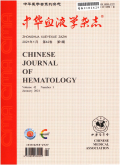极高危原发性轻链型淀粉样变患者的临床特征和预后分析
Analysis of clinical characteristics and outcome of patients with very high risk primary immunoglobulin light-chain amyloidosis
摘要目的 探讨极高危原发性轻链型淀粉样变(pAL)患者的临床特征及其预后.方法 回顾性分析2009年1月至2016年2月在北京协和医院确诊的205例pAL患者的临床资料,将梅奥2004分期Ⅲb期或梅奥2012分期4期的患者定义为极高危患者.结果 34例(16.6%)为极高危pAL患者,中位年龄57(20~84)岁,男性22例(64.7%).所有患者均有心脏受累,15例(44.1%)患者的受累脏器≥3个.27例(81.8%)患者的心功能分级为3~4级,中位血清肌钙蛋白I为0.25(0.08~1.23) μg/L,中位血清N末端B型利钠肽前体为11 733(1 892~103 277) ng/L,中位血清游离轻链差值为403.0(18.1~1 911.6) mg/L,8例(24.2%)患者的骨髓浆细胞比例≥0.100.16例(47.1%)患者采用硼替佐米为主的化疗方案,总体血液学缓解率为58.3%.中位随诊27(1~40)个月,14例(41.2%)患者在诊断后3个月内死亡,中位生存时间仅为4个月.3、6、12和24个月的预期生存率分别为51.3%、44.0%、35.2%和29.6%.一线化疗后获得血液学缓解、未获得血液学缓解以及姑息治疗的患者1年预计存活率分别为90.9%、11.1%及0(P<0.001).结论 极高危pAL患者的预后极差,早期病死率高,获得血液学缓解的pAL患者有着明显更好的预后.
更多相关知识
abstractsObjective To evaluate the clinical characteristics and outcomes of very high risk patients with primary immunoglobulin light-chain amyloidosis (pAL) at a single center in China.Method Clinical data,treatment and outcome of 205 pAL patients in Peking Union Medical College Hospital from January 2009 to February 2016 were retrospectively analyzed.A ‘very high risk’ group includes patients with Mayo 2004 stage Ⅲb and Mayo 2012 stage 4.Results Of 205 patients,34 (16.6%) were defined as very high risk pAL patients.The median age at diagnosis was 57 (20-84) years,and 22 patients (64.7%) were male.All 34 patients were diagnosed with cardiac involvement,multi-organ involvement was observed in 15 patients (44.1%),and 27(81.8%) had New York Heart Association Class Ⅲ or Ⅳ.Median values of serum cTnI,NT-proBNP,and free light chains difference were 0.25 μg/L,11 733 ng/L,and 403 mg/L,respectively.Eight (24.2%) had more than 10% plasma cell on the bone marrow aspirate.Sixteen (47.1%) patients received bortezomib based chemotherapy and overall hematologic response rate was 58.3%.Median overall survival (OS) was 4 months.The estimated OS at 3,6,12,and 24 months was 51.3%,44.0%,35.2%,and 29.6%,respectively.Fourteen (41.2%) patients died within 3 months after the diagnosis.The estimated 1-year survival rate for the patients who got hematologic response,without hematologic response,and palliative treatment was 90.9%,11.1%,and 0,respectively (P<0.001).Conclusion Patients with very high risk pAL had very poor prognosis and the early death rate remained high.Those patients who obtained hematologic remission would have significantly better outcomes.
More相关知识
- 浏览594
- 被引2
- 下载196


相似文献
- 中文期刊
- 外文期刊
- 学位论文
- 会议论文



 换一批
换一批 换一批
换一批



